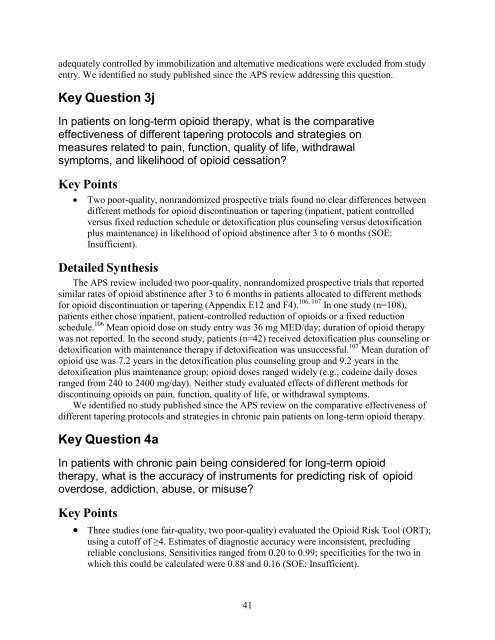chronic-pain-opioid-treatment-report-140929
chronic-pain-opioid-treatment-report-140929
chronic-pain-opioid-treatment-report-140929
Create successful ePaper yourself
Turn your PDF publications into a flip-book with our unique Google optimized e-Paper software.
adequately controlled by immobilization and alternative medications were excluded from studyentry. We identified no study published since the APS review addressing this question.Key Question 3jIn patients on long-term <strong>opioid</strong> therapy, what is the comparativeeffectiveness of different tapering protocols and strategies onmeasures related to <strong>pain</strong>, function, quality of life, withdrawalsymptoms, and likelihood of <strong>opioid</strong> cessation?Key Points• Two poor-quality, nonrandomized prospective trials found no clear differences betweendifferent methods for <strong>opioid</strong> discontinuation or tapering (inpatient, patient controlledversus fixed reduction schedule or detoxification plus counseling versus detoxificationplus maintenance) in likelihood of <strong>opioid</strong> abstinence after 3 to 6 months (SOE:Insufficient).Detailed SynthesisThe APS review included two poor-quality, nonrandomized prospective trials that <strong>report</strong>edsimilar rates of <strong>opioid</strong> abstinence after 3 to 6 months in patients allocated to different methodsfor <strong>opioid</strong> discontinuation or tapering (Appendix E12 and F4). 106, 107 In one study (n=108),patients either chose inpatient, patient-controlled reduction of <strong>opioid</strong>s or a fixed reductionschedule. 106 Mean <strong>opioid</strong> dose on study entry was 36 mg MED/day; duration of <strong>opioid</strong> therapywas not <strong>report</strong>ed. In the second study, patients (n=42) received detoxification plus counseling ordetoxification with maintenance therapy if detoxification was unsuccessful. 107 Mean duration of<strong>opioid</strong> use was 7.2 years in the detoxification plus counseling group and 9.2 years in thedetoxification plus maintenance group; <strong>opioid</strong> doses ranged widely (e.g., codeine daily dosesranged from 240 to 2400 mg/day). Neither study evaluated effects of different methods fordiscontinuing <strong>opioid</strong>s on <strong>pain</strong>, function, quality of life, or withdrawal symptoms.We identified no study published since the APS review on the comparative effectiveness ofdifferent tapering protocols and strategies in <strong>chronic</strong> <strong>pain</strong> patients on long-term <strong>opioid</strong> therapy.Key Question 4aIn patients with <strong>chronic</strong> <strong>pain</strong> being considered for long-term <strong>opioid</strong>therapy, what is the accuracy of instruments for predicting risk of <strong>opioid</strong>overdose, addiction, abuse, or misuse?Key Points• Three studies (one fair-quality, two poor-quality) evaluated the Opioid Risk Tool (ORT);using a cutoff of ≥4. Estimates of diagnostic accuracy were inconsistent, precludingreliable conclusions. Sensitivities ranged from 0.20 to 0.99; specificities for the two inwhich this could be calculated were 0.88 and 0.16 (SOE: Insufficient).41


